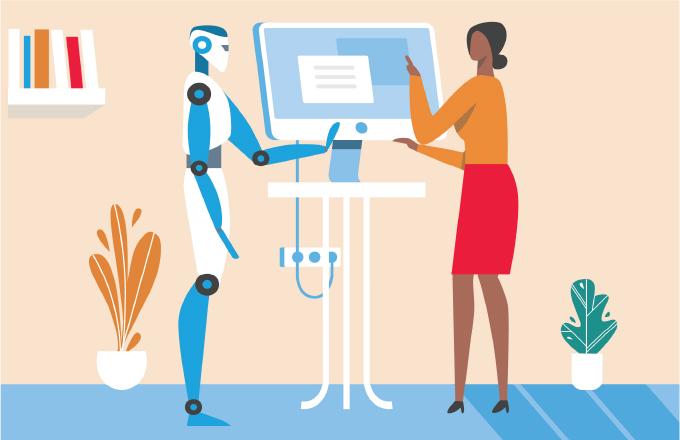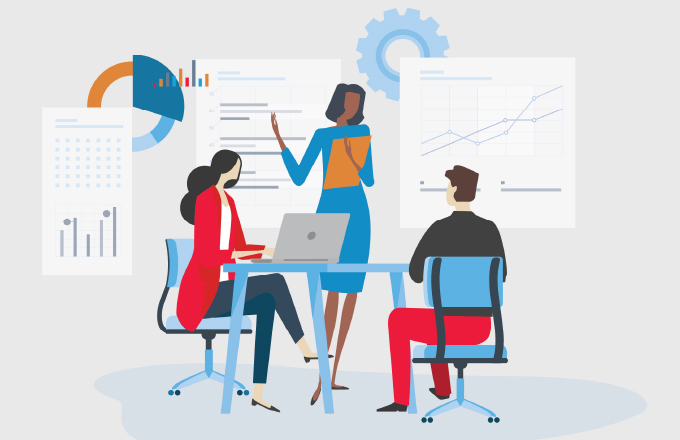What’s Next for Work: Powering Productivity
The net impact of the pandemic on productivity is unclear. On the one hand, more teleworking and greater use of digital solutions have yielded new efficiencies. On the other hand, pandemic-related stress and unavoidable distractions at home have hindered some employee output. The immediate post-COVID period will be critical to ensure the changes to work made in crisis don’t harm long-term innovation efforts or productivity levels.
How do you capitalize on productivity-boosting opportunities while avoiding productivity pitfalls? In the final installment of a three-part series on what’s next for work, we break down the big trends powering productivity growth.
Trend #1: The Digital Leap
Prior to the pandemic, a paradigm shift towards digitization and servitization of the economy was already underway. But COVID-19 has moved the timeline up for many of these disruptive digital trends by as much as five years, forcing businesses to transform, or trail behind. Even organizations that embraced digital solutions before the pandemic have had to accelerate their plans for digital transformation for a world that is becoming digital-first. Everything from internal workflows to customer interfaces must be optimized for a digital environment.
What may not be intuitive in making the leap to digital-first is that technology should come second to people. After all, digital innovations only have value if people actually use them. To fully realize the ROI of their digital investments, organizations must give equal weight to enabling the people using the technology. Reaping the rewards of digital transformation thus hinges entirely on convincing, engaging and empowering people to adopt new digital behaviors. The businesses that have been most successful (so far) in driving behavior change are those that have instituted formal change management programs and extensive training.
“The most transformative technology initiatives go beyond introducing efficiencies; they empower people to think more strategically and solve new problems. But technology isn’t magic—you can’t just push a button and expect immediate change, especially if intended users it haven’t had a seat at the table. The more you can make technological innovation a participative process, the faster you will see meaningful progress.”
- Steve Ferrara, BDO Chief Operating Officer
Trend #2: Reimagining How Work Gets Done
While we have just begun to scratch the surface of what AI and automation can do, we already see the dramatic impact they have had on how work is performed. Automation was displacing jobs before the pandemic, but like so many other digital trends, the coronavirus sped things up, as companies scrambled to find a way to perform jobs that previously required humans to work together in close contact. The robots that have taken over don’t need salaries, don’t get fatigued or sick, and can do the same job at inhuman speed. These substitutions will likely become permanent.

However, in more cases than not, automation, AI and other emerging technologies take over specific job tasks, not entire roles. For example, lawyers working on a case used to have to comb through mountains of potential evidence manually. Now there are tools that can review the evidence and extract the most relevant insights for them. But those tools can’t conduct a negotiation or argue on a client’s behalf in court.
To succeed in the digital economy of tomorrow, companies need to operate at the speed of digital. They need to do more, and they need to do it faster, without sacrificing profits or overworking employees. The only way to meet those lofty goals is to digitize and automate.
Trend #3: People Analytics
As businesses hit accelerate on their digital reinvention, it comes as no surprise that HR is also getting the digital treatment. Central to the transformation of HR is making better use of people data, from how much time they spend on specific tasks to what their work patterns are to how they’re compensated. Organizations are using people analytics to gauge productivity levels, assess current capabilities and critical gaps, track fluctuations in capacity, and optimize resource planning and scheduling. More sophisticated analytics deployments have integrated external data sources for a more holistic view. By harnessing people data, HR departments and organizations at large are unlocking new and better ways of managing, motivating, and measuring the effectiveness of their workforce.

Trend #4: Flexible Resourcing
The digitization of work may be the primary enabler of increased efficiency and output, but true agility requires rethinking organizational systems and structures. During the crisis, organizations designed for agility had a clear performance advantage, better positioned to make rapid decisions under pressure and pivot to higher value activities.
The secret sauce of agile organizations has enough ingredients to fill an entire recipe book, but the practice that gained the most traction during the pandemic is flexible resourcing. Many companies experienced unseasonal demand surges they were understaffed for, while many more faced sharp demand slumps that left them with excess capacity. But some companies considering layoffs or furloughs had critical positions unfilled or unexpected outages. Agile organizations encouraged role mobility through cross-training and were able to redeploy resources where they were most needed.
Meeting the Future of Work
It’s hard to say whether the pandemic, or digital disruption, or some unknowable X-factor will have the greatest influence on productivity growth rates over the next two to three years. How these change agents will continue to evolve is unpredictable, and much is outside businesses’ control. But businesses can control for how they prime their people to adapt to the trends emerging today that, barring another catastrophic event on the same scale as COVID-19, are unlikely to go away. Improving productivity levels will be a test of how effectively organizations facilitate human and machine working together.
SHARE